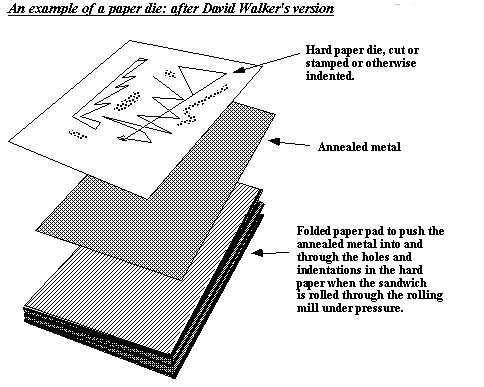How to Do Paper Die Embossing
The annealed metal is placed in a sandwich between soft 'pusher' paper and a hard paper which will serve as a monoprint paper die to emboss the metal sheet. The metal maybe pre-polished which leaves any areas that were cut out in the paper polished and tie surrounding areas matt and slightly textured by the paper.
1 Minute Read
The annealed metal is placed in a sandwich between soft 'pusher' paper and a hard paper which will serve as a monoprint paper die to emboss the metal sheet.
The metal maybe pre-polished which leaves any areas that were cut out in the paper polished and tie surrounding areas matt and slightly textured by the paper. I generally use brown paper towel as my pusher paper and marina file covers as my hard paper. Any highly calendared paper will work as a hard paper die. Any cut or depression in the hard paper will show up on the top. Thus one can press wires or other shapes into the paper which will then show up as positive lines on the metal.
Note that even chasing tools stamped into the paper will produce texture on the metal. Generally one passes the metal through the rolling mill with no pressure, a 'dead pass' and then puts the sandwich together. I usually use six layers of the limn paper towel but you will have to experiment to find the optimum paper thicknesses for what you are doing.
Paper dies offer the user a rapid way of 'drawing in metal, that is of effecting an immediate change in the material This offers a very free way of preparing surfaces and is also ideal for certain kinds of production processes. Because of the variety of ways in which one can affect the paper and the choice of its thickness this approach to surface design is both free and controllable.
The Process is that soft material (metal) is forced under sequential pressure into depressions and holes in the hard die, which here is paper but may be brass or another material if it will stand up to the pressure of the rolling mall. It is a lurid of printmaking, except that here the plates are being affected by the paper.
You assume all responsibility and risk for the use of the safety resources available on or through this web page. The International Gem Society LLC does not assume any liability for the materials, information and opinions provided on, or available through, this web page. No advice or information provided by this website shall create any warranty. Reliance on such advice, information or the content of this web page is solely at your own risk, including without limitation any safety guidelines, resources or precautions, or any other information related to safety that may be available on or through this web page. The International Gem Society LLC disclaims any liability for injury, death or damages resulting from the use thereof.
Charles Lewton-Brain
Master goldsmith Charles Lewton-Brain trained, studied and worked in Germany, Canada and the United States to learn the skills he uses. Charles Lewton-Brain is one of the original creators of Ganoksin.
The All-In-One Jewelry Making Solution At Your Fingertips
When you join the Ganoksin community, you get the tools you need to take your work to the next level.
Trusted Jewelry Making Information & Techniques
Sign up to receive the latest articles, techniques, and inspirations with our free newsletter.
